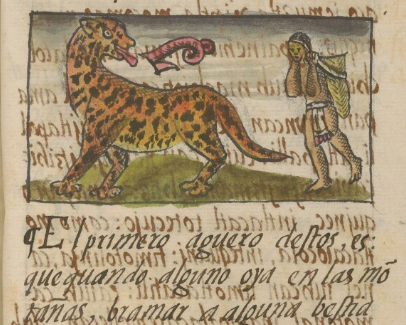tecuani (FCbk5f1r)
This iconographic example of a wild animal (tecuani), likely a jaguar (being golden with black spots), is included here for the purpose of making potential comparisons with hieroglyphs that involve a tecuani. The body of the animal is shown in profile, facing left, but its head is turned around looking backwards toward a man wearing a loincloth, carrying a load in a woven basket, and using a tumpline (mecapalli) to distribute some of the weight to his forehead. He is in the midst of walking (movement), with one foot raised, and his hands are up by his head holding onto the tumpline. He may be on a long-distance marketing journey, and he has come across this wild animal. According to the Digital Florentine Codex team, this man is a tlamama (or tlamamah with the glottal stop). In Mexican Spanish, the term is tameme. His loincloth has red fringe at the bottom. Interestingly, the jaguar is turning back toward the tlamama and making a crying sound (the text employs the word choca, to cry, but the team has added tzatzi/tzatzih as a keyword for this kind of sound). A speech scroll has emerged from the animal’s mouth. The scroll or volute has shading that gives it a three-dimensional look. It also has two added bits that may indicate this is not human speech. One is a round bit with a black dot in the middle; it is placed outside the curl of the volute. The other is a pointed barb; it is attached to the start of the scroll and placed underneath it.
Stephanie Wood
See a few tecuani glyphs below, which show that it is not unusual for the animal to have a protruding tongue and to look like a jaguar.
Stephanie Wood
intequani choca
in tecuani choca
Stephanie Wood
1577
Jeff Haskett-Wood
jaguar, gato silvestre, félido, jaguares, puma, pumas, pantera, panteras, tamemes, volutas, speech scrolls, cacaxtli, mecapal, mecapalli, petlatl, maxtlatl
tecuani, wild animal, beast, jaguar, https://nahuatl.wired-humanities.org/content/tecuani
el jaguar
Stephanie Wood
Available at Digital Florentine Codex/Códice Florentino Digital, edited by Kim N. Richter and Alicia Maria Houtrouw, "Book 4: The Omens", fol. 1r, Getty Research Institute, 2023. https://florentinecodex.getty.edu/en/book/5/folio/1r/images/0 Accessed 29 June 2025.
Images of the digitized Florentine Codex are made available under the following Creative Commons license: CC BY-NC-ND (Attribution-NonCommercial-NoDerivs 4.0 International). For print-publication quality photos, please contact the Biblioteca Medicea Laurenziana ([email protected]). The Library of Congress has also published this manuscript, using the images of the World Digital Library copy. “The Library of Congress is unaware of any copyright or other restrictions in the World Digital Library Collection. Absent any such restrictions, these materials are free to use and reuse.”




